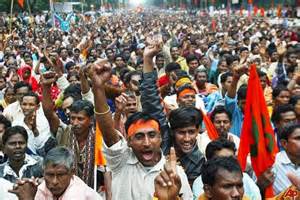On the tip of the Arabian peninsula. Yemen is a large country. It is just smaller than France but two-thirds of it is uninhabited.
Yemen borders in the west by the Red Sea; on the north by Saudi Arabia; on the East by Oman and on the south by the Gulf of Aden.
In the west lies a wide coastal strip the Tihama along a range of mountains. The highest peak Jaban an-Nabi Shu'ayh is 3700m. Behind the mountains lies a fertile high plateaux. In the middle of it is the capital San'a at an altitude of 2250m.
In these highlands are active volcanoes with hot springs and some times earthquakes.
The lower mountains towards Oman, in the east, are only 1000m high.
In the north the southern end of the Arabian Desert riches into Yemen till the middle of it.
AGRICULTURE
Yemen has twice a year a monsoon coming from the south. It make the country the most arable spot on the Arabian peninsula. The temperature various between regions and seasons.
Tihama and the southern coast are hot and with high humidity and a daytime temperatures topping 40C in summer.
Yemen cultivated so much land that little natural vegetation remain. In Tihama there are mangroves, salt-resistant plants pm the seashore and sparse grasses and shrubs on the dune valleys.
Inland, around the wadis and in the mountain foothills, the land is moist enough for evergreen plants growing, including palms and acacias.
Hunting had killed off most of the wild animals. There were leopards, gazelles, hyenas and jackals in southern Yemen.
TRIBAL LIFE
Yemen is a tribal society and the tribes are joined in 'federation'. Most people live in houses built of natural material. on the plains and around wadis, building materials are mud, brick and reeds.
Mountain houses are mostly build with stones.
RELIGION
The state religion is Islam while in the south are mostly Sunni Muslims and in the north are Shi'a sect. There was a minority of Jews but when the Israel was established in 1948 the majority left.
Yemen is a developing country with little industry. The majority is agriculture with most of the crops for its people.
Tropical fruit is grown on low level. At the middle level cereal is grown and at high level are coffee and qat grown to export. On the central highlands sorghum , vegetables and spices are grown.
OIL ECONOMY
Oil was discovered in Marib in late 1980 but the output is low. The Yemen economy was mainly supported by its people working in oil-rich Gulf states.
In October 1990, Saudi Arabia expelled over 1 million Yemenis because the country would support during the Gulf war. Most Arab countries and USA stopped economic aid and co-operation which a devastating impact.
HISTORY
Yemen used to be split into North and South Yemen. The North was ruled by an Imam, a religious leader, but was overthrown by a revolution. Civil war continued until the 1970 when religious leaders agreed to a republican government run by the military. The country was renamed the Yemen Arab Republic (YAR).
Both north and south Yemen wanted to be reunited but the official relations between were bad.
In 1980, The PDRY soften on its hard-line Marxist beliefs and better relation ship with YAR followed.
In 1990 unification was declared. The first free election in the whole Arabian peninsula were held in April 1993 and a coalition government was formed between the three major parties.
 |
| YEMEN'S CAPITAL SAN'A |











